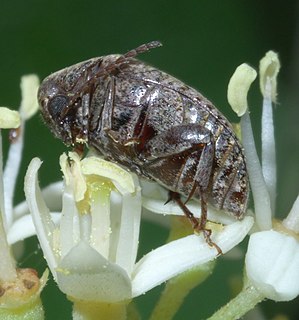
The patella, also known as the kneecap, is a flat, circular-triangular bone which articulates with the femur and covers and protects the anterior articular surface of the knee joint. The patella is found in many tetrapods, such as mice, cats and birds, but not in whales, or most reptiles.
Glaresis is a genus of beetles, sometimes called "enigmatic scarab beetles", in its own family, the Glaresidae. It is closely related to, and was formerly included in, the family Scarabaeidae. Although its members occur in arid and sandy areas worldwide, only the nocturnal adults have ever been collected, and both the larvae and biology of Glaresis are as yet unknown. Due to their narrow habitat associations, a great number of these species occur in extremely limited geographic areas, and are accordingly imperiled by habitat destruction.

The Hystricognathi are an infraorder of rodents, distinguished from other rodents by the bone structure of their skulls. The masseter medialis passes partially through the infraorbital foramen and connects to the bone on the opposite side. This, together with their lack of an infraorbital plate and the relative size of the infraorbital foramen, distinguishes hystricognaths from other rodent groups.
The rectus femoris muscle is one of the four quadriceps muscles of the human body. The others are the vastus medialis, the vastus intermedius, and the vastus lateralis. All four parts of the quadriceps muscle attach to the patella by the quadriceps tendon.

The Encyclopedia of Life (EOL) is a free, online collaborative encyclopedia intended to document all of the 1.9 million living species known to science. It is compiled from existing databases and from contributions by experts and non-experts throughout the world. It aims to build one "infinitely expandable" page for each species, including video, sound, images, graphics, as well as text. In addition, the Encyclopedia incorporates content from the Biodiversity Heritage Library, which digitizes millions of pages of printed literature from the world's major natural history libraries. The project was initially backed by a US$50 million funding commitment, led by the MacArthur Foundation and the Sloan Foundation, who provided US$20 million and US$5 million, respectively. The additional US$25 million came from five cornerstone institutions—the Field Museum, Harvard University, the Marine Biological Laboratory, the Missouri Botanical Garden, and the Smithsonian Institution. The project was initially led by Jim Edwards and the development team by David Patterson. Today, participating institutions and individual donors continue to support EOL through financial contributions.
Encheloclarias is a genus of airbreathing catfishes endemic to Southeast Asia.

Glaucidium kurochkini is an extinct species of pygmy owls that existed in what is now California, U.S.A. during the late Pleistocene epoch.
Polyacanthia medialis is a species of beetle in the family Cerambycidae. It was described by Sharp in 1886, originally under the genus Poecilippe.
Orongia is a genus of spiders in the Orsolobidae family. It was first described in 1985 by Forster & Platnick. As of 2017, it contains 3 species, all from New Zealand.
Ceratomegilla is a genus of lady beetles in the family Coccinellidae. There are about seven described species in Ceratomegilla.
Ceutorhynchus medialis is a species of minute seed weevil in the beetle family Curculionidae. It is found in North America.

Lichenomima is a genus of mouse-like barklice in the family Myopsocidae. There are more than 40 described species in Lichenomima.

Sminthurus medialis is a species of globular springtail in the family Sminthuridae.
Asagena medialis is a species of cobweb spider in the family Theridiidae. It is found in the United States and Mexico.
Glaresis inducta is a species of enigmatic scarab beetle in the family Glaresidae. It is found in North America.
Hyperaspis medialis, the medial lady beetle, is a species of lady beetle in the family Coccinellidae. It is found in North America.

Amblycerus is a genus of pea and bean weevils in the beetle family Chrysomelidae. There are more than 60 described species in Amblycerus.
Glaresis ecostata is a species of enigmatic scarab beetle in the family Glaresidae. It is found in North America.

Bathythrix is a genus of ichneumon wasps in the family Ichneumonidae. There are at least 60 described species in Bathythrix.
Rhyssomatus medialis is a species of true weevil in the beetle family Curculionidae. It is found in North America.








